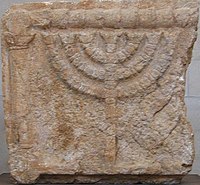| Revision as of 01:52, 27 March 2014 edit23.240.42.216 (talk) Undid revision 601030894 by Zero0000 (talk) Reverted Israel denialTag: Non-autoconfirmed user rapidly reverting edits← Previous edit | Revision as of 02:03, 27 March 2014 edit undoSupreme Deliciousness (talk | contribs)Extended confirmed users, Pending changes reviewers, Rollbackers22,583 edits Undid revision 601445530 by 23.240.42.216 (talk) drive-by disruption.Next edit → | ||
| Line 1: | Line 1: | ||
| ]'' from the ], ], ], dating from around the 4th–5th century CE]] | ]'' from the ], ], ], dating from around the 4th–5th century CE]] | ||
| ], ]]] | ], ]]] | ||
| '''Ancient synagogues in Palestine''' refers to ]s built by the ] community in ] from antiquity to the early ]. | '''Ancient synagogues in Palestine''' refers to ]s built by the ] community in ] from antiquity to the early ]. | ||
Revision as of 02:03, 27 March 2014


Ancient synagogues in Palestine refers to synagogues built by the Jewish community in Palestine from antiquity to the early Middle Ages.
History
Most of the synagogues unearthed in archaeological excavations in Israel date from the Roman and Byzantine periods, from the third to seventh centuries. Synagogues from before the destruction of the Second Temple in 70 CE include Gamla, Masada and Herodium. The oldest remains of a Palestinian synagogue dates from the 1st-century CE. After the destruction of the Temple in Jerusalem, the local synagogue became its substitute and from Late Antiquity onward, the number of synagogues discovered rise significantly, with over one hundred being unearthed in Palestine alone. Over fifty of these are situated in Galilee and on the Golan Heights.
A survey conducted in the 1970s found that of the known synagogue inscriptions, 67 were in Greek and found in the coastal and major inland cities. Another 54 were in Aramaic, and 14 in Hebrew. The vast majority of inscriptions are dedicatory, while the remainder feature literary sources or are short labels for images. Decorations used on mosaic floors, capitals and lintels were symbolic of the Temple service and included the menorah, lulav and etrog. Aside from remains found in-situ, architectural elements of the synagogues are often found to have been reused in the houses of adjacent villages. Sometimes dressed stones were transferred further afield and lintels from the doorways of ancient Palestinian synagogues are also to be found in contemporary homes in Syria.
The earliest synagogue inscription found in Israel is in Greek and dates to the first century BCE or the first century CE. It was discovered just south of the Temple Mount in Jerusalem:
- "Theodotos, son of Vettenos the priest and synagogue leader , son of a synagogue leader and grandson of a synagogue leader, built the synagogue for the reading of the Torah and studying of the commandments, and as a hostel with chambers and water installations to provide for the needs of itinerants from abroad, which his fathers, the elders, and Simonides founded."
All of the early synagogues were purpose-built and many synagogues dating to the talmudic era onwards had annexes attached to the main structure, indicating that synagogues additionally functioned as a communal centres.
Ancient synagogue sites
|
A B C D E G |
H
J K M N |
P Q R S T U Y W Z |
See also
References
- ^ Lee I. Levine (1998). Judaism and Hellenism in antiquity: conflict or confluence. University of Washington Press. p. 139. ISBN 978-0-295-97682-2. Retrieved 7 June 2011.
- ^ Philip Khuri Hitti (30 January 2004). History Of Syria: Including Lebanon And Palestine. Gorgias Press LLC. p. 365. ISBN 978-1-59333-119-1. Retrieved 7 June 2011.
- Lee I. Levine (May 1982). Ancient synagogues revealed. Israel Exploration Society. p. 12. ISBN 978-0-8143-1706-8. Retrieved 10 June 2011.
- Lee I. Levine (1975). Caesarea under Roman rule. Brill Archive. p. 198. ISBN 978-90-04-04013-7. Retrieved 7 June 2011.
- ^ Eric M. Meyers; American Schools of Oriental Research (1997). The Oxford encyclopedia of archaeology in the Near East. Oxford University Press. p. 114. ISBN 978-0-19-511219-1. Retrieved 7 June 2011.
- ^ John S. Kloppenborg; Stephen G. Wilson; Canadian Society of Biblical Studies (1996). Voluntary associations in the Graeco-Roman world. Psychology Press. p. 102. ISBN 978-0-415-13593-1. Retrieved 7 June 2011.
- Raphael Greenberg, Adi Keinan. Israeli Archaeological Activity in the West Bank 1967-2007: A Sourcebook, Ostracon 2009. pg. 136. ISBN 978-965-91468-0-2.
- Julian Lincoln Simon (1 January 1990). Population matters: people, resources, environment, and immigration. Transaction Publishers. p. 460. ISBN 978-1-56000-895-8. Retrieved 24 June 2011.
- Ben Tsiyon Rozenfeld; Joseph Menirav; Chava Cassel (2005). Markets and marketing in Roman Palestine. BRILL. p. 223. ISBN 978-90-04-14049-3. Retrieved 7 June 2011.
Bibliography
- Lester L. Grabbe. Synagogues in Pre-70 Palestine: A Re- Assessment, JTS 39 (1988).
- S. Krauss. Nouvelles decouvertes archeologiques de synagogues en Palestine, REJ 89 (1930).
- LI Levine. The Nature and Origins of Palestinian Synagogues, JBL 115 (1996).
- Jodi Magness. Heaven on Earth: Helios and the Zodiac Cycle in Ancient Palestinian Synagogues, Dumbarton Oaks Papers, Vol. 59, (2005), pp. 1-52.
- EL Sukenik. Ancient Synagogues of Palestine and Greece, (London, 1934).
- Dan Urman, Paul Virgil McCracken Flesher. Ancient synagogues: historical analysis and archaeological discovery, BRILL, 1998.